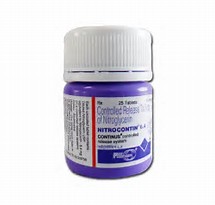Drugs used in treatment of Angina Pectoris.
Drugs used in the treatment of Angina Pectoris.
- Angina pectoris is clinical condition alarming cardiac ischemia characterized by sudden and acute substernal pain usually referring towards left shoulder, sometimes associated with breathlessness, anxiety, sweating and rapid irregular heartbeats.
- The drugs used in the treatment of Angina are called as "Antianginal drugs."
Mechanism of Action of Antianginal drugs:
- Basic pathophysiology of Angina, in a nutshell, is Imbalance between cardiac muscle oxygen demand and supply ----------> cardiac ischemia ------------> myocardial infarction.
- Hence the targeted drugs should act by,
- Increasing cardiac blood supply.
- Decreasing cardiac workload.
Classification of Antianginal Drugs:
A) Nitrates:
- They act by stimulating EDRF (Endothelial Derived Relaxing Factor).
- By causing peripheral vasodilation they reduce venous return and hence decreases cardiac workload.
- They have direct vasodilation action on coronary artery and hence relieves obstruction to blood flow and restores cardiac blood flow.
- Short-Acting Nitrates: Nitroglycerine, GTN (Glyceryl Tri Nitrate).
- Long-Acting Nitrates: Isosorbide Mono Nitrates, Isosorbide Di Nitrate, Erythryl tetranitrate.
B) Beta Blockers:
- Beta blockers are the pharmacological agents which block actions of adrenaline mediated through adrenergic beta receptors.
- Beta-blockers hence decrease contractility, conductivity, rhythmicity and automaticity of heart.
- They are known to increase rest period of cardiac muscles.
- Hence as they reduce functioning of heart they also lower the oxygen demand and are used in prophylaxis of exertional angina (Stable angina).
- However, they are contraindicated in "variant angina (associated with spasm of a coronary artery).
- Beta blockers are also contraindicated in diabetes and heart failure.
- Acebutolol.
- Metoprolol.
- Propranolol.
- Oxprenolol.
- Alprenolol.
C) Calcium Channel Blockers:
- These are peripheral vasodilators which act by blocking calcium ion channels.
- These drugs reduce venous return and hence decrease cardiac workload.
- They also possess negative chronotropic and inotropic effects.
- Verapamil
- Nifedipine.
- Amlodipine.
- Diltiazem.
- Lacidipine.
D) Potassium Channel Openers.
- As the name indicates they act by opening potassium channels causing vasodilation.
- Their mechanism is identical to calcium channel blockers.
- Minoxidil.
- Nicorandil.
- Diazoxide
E) Miscellaneous:
- Dipyridamole.
- Trimetazidine.
- Oxyphedrine.
- Atorvastatin.
- .
Labels: Pharmacology







<< Home